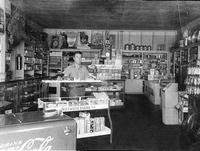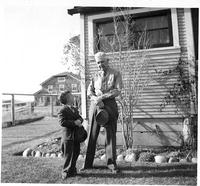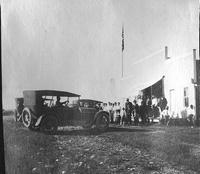|
The Sublette County Journal Volume 3, Number 26 - 7/29/99 brought to you online by Pinedale Online
More than shopping, the Daniel Store was a community gathering place. by Dudley Key Any story about the Daniel Store must begin with my grandfather, Elmer Dudley Key. The following story, written by Dudley Key, has been condensed from the original version which will appear in a book celebrating Daniel, Wyoming's centennial, her people, and the surrounding valley. Any story about the Daniel Store must begin with my grandfather, Elmer Dudley Key, known as Dick. He was born October 27, 1878 near Marysville, Missouri on a farm owned by his father, James L. Key. While at college, Dick met Dan B. Budd from Big Piney, Wyoming, who was also attending the school. My granddad was not thriving in the damp midwestern climate, suffering from what was then called consumption. Budd persuaded him to come West to the higher, drier climate and either be killed or cured. Dick was a tall, slender man of surprising strength, which was not evident until you saw him moving 100 1b. sacks of grain or potatoes. In 1908, Dick, D. B. Budd, and L. D. Tanner formed the Big Piney Mercantile Company, where Dick worked as secretary-treasurer for the next several years. Dick soon met and courted Addie Chamberlin, who lived on the Flying V Ranch near Daniel. They were married at the Flying V on June 9, 1909. Both of their children, Beulah and Richard, were born on the ranch. Zeph Jones, who had been the U.S. Forest Service supervisor based in Kendall, quit or retired from the government in 1905 and purchased an interest in an existing Pinedale store from S. L. Spicer. Jones bought Spicer's share of the business in January of 1910 and formed a company called Jones and Son Company, the son being Arch Jones. Arch later married Beulah Chamberlin, Addie Key's sister.
Dick named his store, "E.D. Key & Son, General Merchandise". I think he intended for his son Richard to eventually enter the business. But, Richard, like Arch Jones before him, did not relish the confinement and long hours of a country storekeeper. Life in the store business was not always smooth for my grandparents, as yet another store was built across the street in September of 1916 by Barber & Pixley, who had been located in the old Thomas Daniel/Richardson building (now the Green River Bar). Daniel was a crossroads and shopping center for the immediate area, but two stores in town was one too many. Also the world was on the brink of World War I and the era was one of uncertainty. Then came prohibition and the great depression - all challenges to a businessman of the times. I remember my grandfather wading through mountains of paperwork to comply with the provisions of rationing during World War II. It is amazing that Dick Key not only survived, but also prospered during his years in Daniel. In the beginning, Thomas Daniel had built his store some twenty miles North of Big Piney, shortly before the turn of the last century and gave the ensuing settlement his name - Daniel. Later, his store was operated by my great grandmother, Caroline Richardson and her son, Austin. She and Austin operated the store from 1907 to 1912, then sold to Barber & Pixley, who would later be in competition with my grandfather. That store, built by Thomas Daniel, still stands and now houses the Green River Bar. General stores carried grocery staples such as flour, sugar, coffee, and basic canned goods. Milk, fresh meat, produce, bread, and any kind of prepared food was not an option. Different stores carried or specialized in different types of goods, depending on the proprietor's expertise and interests and the demands of the customers in the area. The Opal Merc had an extensive stock of dry goods, courtesy of Pete Petrie, who was trained in that line in his native Scotland. The Big Piney Merc sold farm machinery reflecting the background of L. D. Tanner. Jones & Son Company sold wagons, machinery and autos as per Zeph and Arch Jones's interest in transportation. All the stores carried essential hardware such as nails, staples, barbed wire, buckets, tubs, and necessary tools like shovels, axes, hammers, and pliers. They also had work clothes, patent medicines for people and animals, and in our area, grain for animal feed. Many stores sold gasoline and oil with the advent of the automobile. Because of the isolation due to the difficulty of transportation, these stores had to be all things to all people in their communities. Most would special order what they didn't stock. The improvement of the roads and cars eventually sounded the death knell for the old general stores, here and nationwide.
During haying seasons we saw Indians from the reservations, farm hands from Oklahoma and Arkansas, and drifters of all kinds, including Mickey McKnight. Our cowboys in those days had national reputations as rodeoers and were our (the boys of Daniel) heroes. The Meeks brothers, Vern and Ross, George Conwell, Mick Hicks, Charlie Stegman, Eddie Holladay, and Gene Pfisterer seemed bigger and tougher than real life or the imitations in the movies. The north storeroom of the store was stacked to the ceiling with l0O lb. sacks of grain and made fine hideouts for gunfighters, like myself, at the time. Also in this room were packsaddles, horse collars, horseshoes, kegs of nails, and l00# sacks of potatoes and dry beans. At the back of this room was a small, cool room with walls a foot thick and filled with sawdust. This was vented to the outside on the north wall and stayed cool enough for bacon slabs, cured hams, and cheeses, which were the only meats we carried. Next to the cool room was a platform scale to weigh merchandise, and written on the wall next to it, were the weights and heights of my father and my aunt at various ages. My own were, of course, added. In the main, central room of the store were shelves along all the walls for the goods for sale. In front of the shelves were counters on the grocery side and showcases of wood and glass for the dry goods side. In the rear was a wooden island built to hold coats and dresses on hangers on one side, and with bins for nails and staples on the other. Facing the front were three slot machines, one of which was owned by my grandmother; the others were on shares from Harry Jiacolleti of Kemmerer, who had a string of them all over southwest Wyoming. We had a pop cooler in the middle of the store in the summer. One of my jobs was carrying 50# blocks of ice for the cooler and for the icebox in the house. During the winter, the cooler disappeared and a large potbelly stove was placed in the middle of the room. This became a visiting place for whatever old cowboy or trapper who decided to winter in town. They drove my granddad up the wall, because he couldn't break them from spitting in the coal bucket, and they all chewed either snoose (Copenhagen) or plug tobacco. We sold Stetson hats, Levis, Pendleton, and Woolrich shirts and caps. The Winchester rifles were all very interesting to a small, adolescent boy. The south storeroom contained a 32-volt light plant and a series of storage batteries, which provided electricity for reading lights, and that's all. It also was stacked with the remainder of the grocery stock - cases of canned goods, 50 and l00# sacks of flour and sugar, 25# tins of coffee, and 50# tins of lard. Our customers were mainly ranchers demanding their supplies in large quantities, as a trip to town was an expedition, not a lark. Our living quarters were situated at the rear of the store building. We had a large living/dining room, a big kitchen with a pantry, and a breakfast alcove. My grandparents had a big bedroom with a linen closet off the kitchen. At the north end of the living area were a comfortable guest bedroom and two small bedrooms, which had been my father's and my Aunt Beulah's. One of these was mine when I made my appearance; I still remember going to sleep, listening to the croaking of the frogs in the summer and the coyotes' howling in the winter. There was a screen porch on the back of the building furnished with wicker furniture. It was a fine place to enjoy summer evenings. This porch also housed the water pump, the icebox for the house, and my grandmother's washing machine, which was hand-operated and resembled a gold-panning machine. My grandmother loved her garden in the backyard, and we had a nice lawn and many flowerbeds that were watered by a ditch running through the yard south to Blackmon's and ending in a marsh south of town. It was fed by the irrigation ditch at the north edge of town next to the tourist court (Strieby's and before that, Yarger's cabins). When the road was paved in the `40s, the highway department had to install a sluice under the highway to satisfy our water rights. The ditch through the yard was connected to a network of very small waterways around the yard and flowerbeds. Periodically during the summer, we would drain the ditch with a small wooden headgate, causing it to flow through the network and water the whole yard. My grandfather was appointed postmaster in 1941, so we partitioned off a section of the northeast part of the main store area for a post office. The war years were difficult for the small storeowner with rationing and the scarcity of many kinds of merchandise, so the post office was a welcome supplement to the family income. Also, granddad was getting up in years and feeling the strain of the hard work involved in the store operation. After my grandmother's death in 1948, granddad leased out the store, finished his term as postmaster and retired. He moved to Kemmerer and lived to the age of 91. The Daniel Store later was operated by Leo and Judy Livingston, me, Owen Reed, Joel Dustin, and Carl and Jackie Hunt, and still stands today, although no longer as a general merchandise establishment. I shall always remember and treasure my growing up years in Daniel and the store. Daniel will always be my hometown. See The Archives for past articles. Copyright © 1999 The Sublette County Journal All rights reserved. Reproduction by any means must have permission of the Publisher. The Sublette County Journal, PO Box 3010, Pinedale, WY 82941 Phone 307-367-3713 Publisher/Editor: Rob Shaul editor@scjonline.com |


